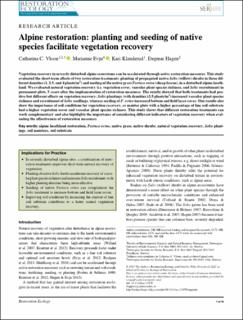| dc.description.abstract | Vegetation recovery in severely disturbed alpine ecosystems can be accelerated through active restoration measures. This study evaluated the short-term effects of two restoration treatments, planting of propagated native Salix (willow) shrubs in three different densities (1, 2.5, and 4 plants/m2) and seeding of the native grass Festuca ovina (sheep fescue), in a disturbed alpine heathland. We evaluated natural vegetation recovery (i.e. vegetation cover, vascular plant species richness, and Salix recruitment) in permanent plots, 5 years after the implementation of restoration measures. The results showed that both treatments had positive but different effects on vegetation recovery; Salix plantings (with densities ≥2.5 plants/m2) increased vascular plant species richness and recruitment of Salix seedlings, whereas seeding of F. ovina increased bottom and field layer cover. Our results also show the importance of soil conditions for vegetation recovery, as moister plots with a higher percentage of fine soil substrate had a higher vegetation cover and vascular plant species richness. This study shows that different restoration treatments can work complementary and also highlights the importance of considering different indicators of vegetation recovery when evaluating the effectiveness of restoration measures. | |
